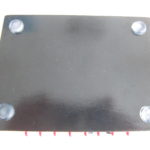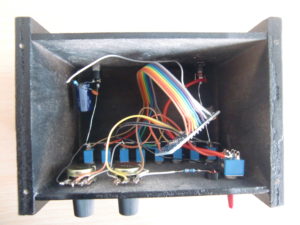Arduino Mini-Pops
by admin


I found on a side Korg Mini-Pops DIY Drum Machine and further on The O2 source code. I thought, I’d like to try that out.
I ordered all parts and do it for simplicity flying wire.
I made the housing from wood. The front and rear panels are 3 mm birch plywood and the sides are 8mm beech plywood.
Beech plywood 8 mm
1 piece 136 mm x 100 mm
2 piece 92 mm x 100 mm
1 piece 120 mm x 100 mm
birch plywood 3 mm
2 piece 120 mm x 84 mm
I only screwed the lid. That allows enough space to work.
I drill the front and back panels and then glued all parts except the lid. Then I mix gypsum and primed all visible sides. After drying everything was sanded off, so that a smooth surface could be formed and then painted black.
For the front I made a layout with the free front panel designer from Schaeffer and printed it as a PDF. Then I cut out the elements and glued it. Then I sprayed everything with clear lacquer.
I unfortunately have set the order of the instruments differently than they are controlled in the program, as you can see on the pictures
The correct order is:
- Quijeda
- Cymbal
- Maracas
- Cowbell
- Claves
- Bass Drum
- Bongo
- Guiro
For the feets I have used quite simple self-adhesive noise stops from a hardware store.

Here again the front and back panel at the finished instrument.
You can see that the labels are glued, but I think that is OK.
What does it cost:
| 1 x | Arduino Nano Compatible | 1,84 € |
| 9 x | Miniature toggle switch | 1,99 € |
| 2 x | Potetiometer 10k Lin (hier 5 x) | 1,82 € |
| 2 x | Rotary Knob 6mm Blue (hier 10 x) | 1,16 € |
| 1 x | Built-In Jack 3,5mm | 0,85 € |
| 1 x | Barrel Connector Socket Ø = 2,1mm | 0,27 € |
| 1 x | Ceramic Capacitor 100N | 0,07 € |
| 1 x | Electrolytic Capacitor 10 uF | 0,11 € |
| 1 x | Resistor 1 kOhm | 0,082 € |
| 1 x | LED, 5 mm, Red | 0,06 € |
| 1 x | Resistor 680 Ohm | 0,082 € |
| Wood cuttings | ca. 5,00 € | |
| Colour and small parts | ca. 8,00 € | |
| ca. 20,00 € |
What is still needed is either a 9 Volt plug-in power supply or an adapter to connect to a 9 Volt block battery.
For a new version, I have created a circuit diagram with ExpressSCH and designed a board with ExpressPCB. In addition I have an LED and a connector for the reset signal as pulse display, and a MIDI output and a connector for the clock signal provided.
I do not like at all the patterns to be adjusted via a normal potentiometer. It would be more beautiful with a rotary switch. Maybe later on I’ll make a new version with a rotary switch.
I found on a side Korg Mini-Pops DIY Drum Machine and further on The O2 source code. I thought, I’d like to try that out. I ordered all parts and do it for simplicity flying wire. I made the housing from wood. The front and rear panels are 3 mm birch plywood and the sides…




